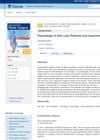Inherited Hairlessness: A Case Study of Familial Congenital Atrichia
April 2023
in “
Curēus
”

TLDR The document concludes that the girl's hairlessness is likely inherited from her parents.
This document discusses a rare case of familial congenital atrichia, a disorder characterized by the absence of hair at birth or hair loss within the first six months of life, with no subsequent hair growth. The condition also involves a lack of pubic and axillary hair and minimal brow, eyelash, and body hair. While it can occur sporadically, the condition often has an autosomal recessive inheritance pattern, though there have been instances of dominant inheritance. The case study focuses on a 16-year-old girl with congenital atrichia, noting that her parents also exhibit clinical features of the disorder, suggesting a genetic component to her condition.






